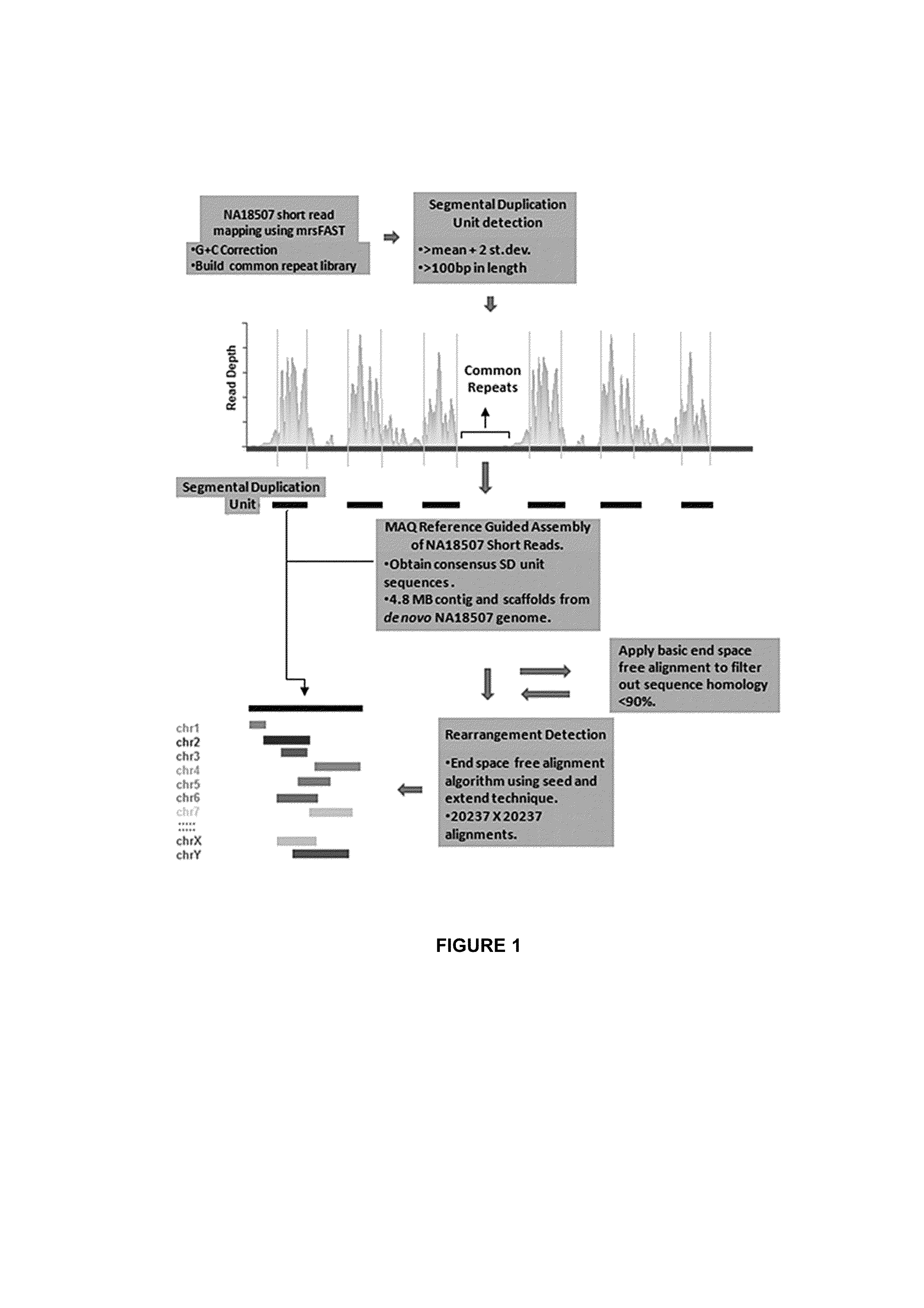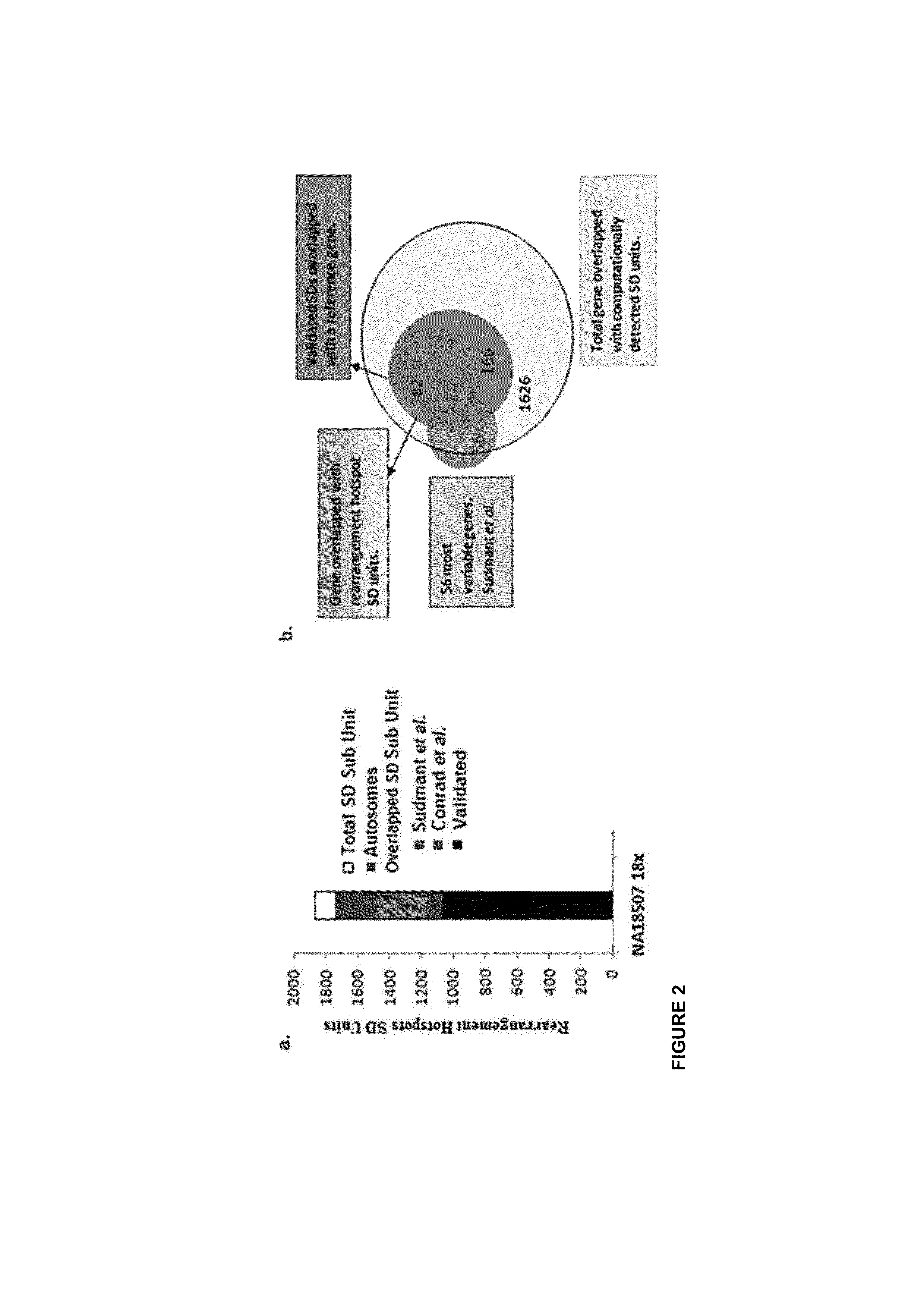Genome-wide detection of genomic rearrangements and use of genomic rearrangements to diagnose genetic disease
a genomic rearrangement and genome-wide technology, applied in the field of genome-wide detection of genomic rearrangements and use of genomic rearrangements to diagnose genetic diseases, can solve the problems of complex structural architecture of human genomes, unable to fully understand the role of disease pathogenesis, and evolutionary conservation of these mechanisms, and complicating the identification of sd breakpoints
- Summary
- Abstract
- Description
- Claims
- Application Information
AI Technical Summary
Benefits of technology
Problems solved by technology
Method used
Image
Examples
example 1
Identification of “Rearrangement Hotspots” within Segmental Duplications in Humans
Detection of Segmental Duplication (SD) Units
[0182]Given that SDs intuitively consist of common repeat elements, SDs were fragmented into multiple smaller SD units which did not overlap with known repeat elements during the read depth-based analysis. In this study, 20,237 non-redundant sets of SD units with at least one inter- or intra-chromosomal rearrangement event were identified, representing 16.65 Mbp of SD units residing outside of common repeat elements in the human genome. At first glance, this total content of SDs may appear small compared with that previously reported [Bailey J A et al, (2002)] and that reported in the database of genomic variants (DGV) which is mainly attributed to methodological differences (i.e., exclusion of common repeats, GC-correction, shorter window length, low read depth threshold). Results from this study and Perry at al [Perry H G at al. (2008)], suggest that previ...
example
[0204]
S1:(SEQ ID NO: 1)ACGCAATTCGACTAGATCGGGTCGATGATCGATCGATGATCGAGACAGCATAGCAGS2:(SEQ ID NO: 2)CAATTCGACTAGATCGATCGACGATCGATCGATSemi-Global Alignment:S1:(SEQ ID NO: 1)ACGCAATTCGACTAGATCGGGTCGATGATCGATCGATGATCGAGACAGCATAGCAGS2:(SEQ ID NO: 3)***CAATTCGACTAGATC*GATC***GA*CGATC***GAT*****C*G*AT*****End-Space Free Alignment:S1:(SEQ ID NO: 4)CAATTCGACTAGATCGGGTCGATGATCGATCGATS2:(SEQ ID NO: 5)CAATTCGACTAGATC*GATCGACGATCGATCGAT
[0205]In order to implement the algorithm, a dynamic programming technique was utilized which is a modified version of Smith-Waterman dynamic programming [Smith I F et al. (1981)]. This approach will detect the pairwise alignment relative to a penalty function corresponding to semi-global alignment. The dynamic programming (DP) algorithm was used to compute the above alignments and the backtrack pointer was used to identify the best alignment.
Dynamic Programming Matrix and Recursive Trace Back
[0206]As a core searching algorithm, a penalty function was implemented to ...
example 2
Microarray Chips for Detecting Genomic Aberrations
[0212]A custom aCGH microarray was designed based on the rearrangement hotspots identified in Example 1. In all, approximately 500 MB of the human genomic sequence was covered within a 2×1 million probe (1 M) microarray. The Agilent custom microarray identification numbers are 035313 and 035316.
[0213]The genomic regions covered by the microarray were chosen as follows:
[0214]a) All the breakpoints (ie. “rearrangement hotspots”) identified in Example 1 were accommodated (Table 1).
[0215]b) The location of the hotspots and how far they are from each other was considered. If two hotspots were within 1 MB from each other, the entire region between the two hotspots was included.
[0216]c) Known CNV regions previously identified in the literature were included.
[0217]d) At least 1 MB of the telomeric and centromeric regions for all chromosomes were also included.
[0218]Probes were designed to be 45-60 basepairs in length. Probe spacing ranges be...
PUM
| Property | Measurement | Unit |
|---|---|---|
| length | aaaaa | aaaaa |
| Autism Spectrum Disorder | aaaaa | aaaaa |
| Spectrum | aaaaa | aaaaa |
Abstract
Description
Claims
Application Information
 Login to View More
Login to View More - R&D
- Intellectual Property
- Life Sciences
- Materials
- Tech Scout
- Unparalleled Data Quality
- Higher Quality Content
- 60% Fewer Hallucinations
Browse by: Latest US Patents, China's latest patents, Technical Efficacy Thesaurus, Application Domain, Technology Topic, Popular Technical Reports.
© 2025 PatSnap. All rights reserved.Legal|Privacy policy|Modern Slavery Act Transparency Statement|Sitemap|About US| Contact US: help@patsnap.com



